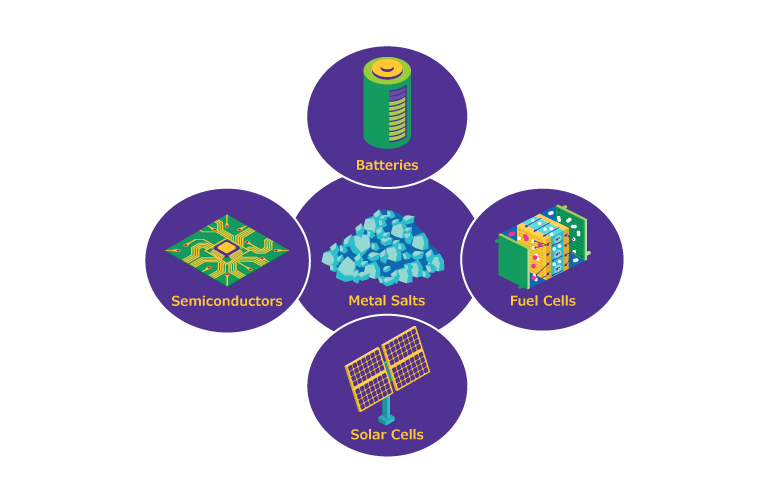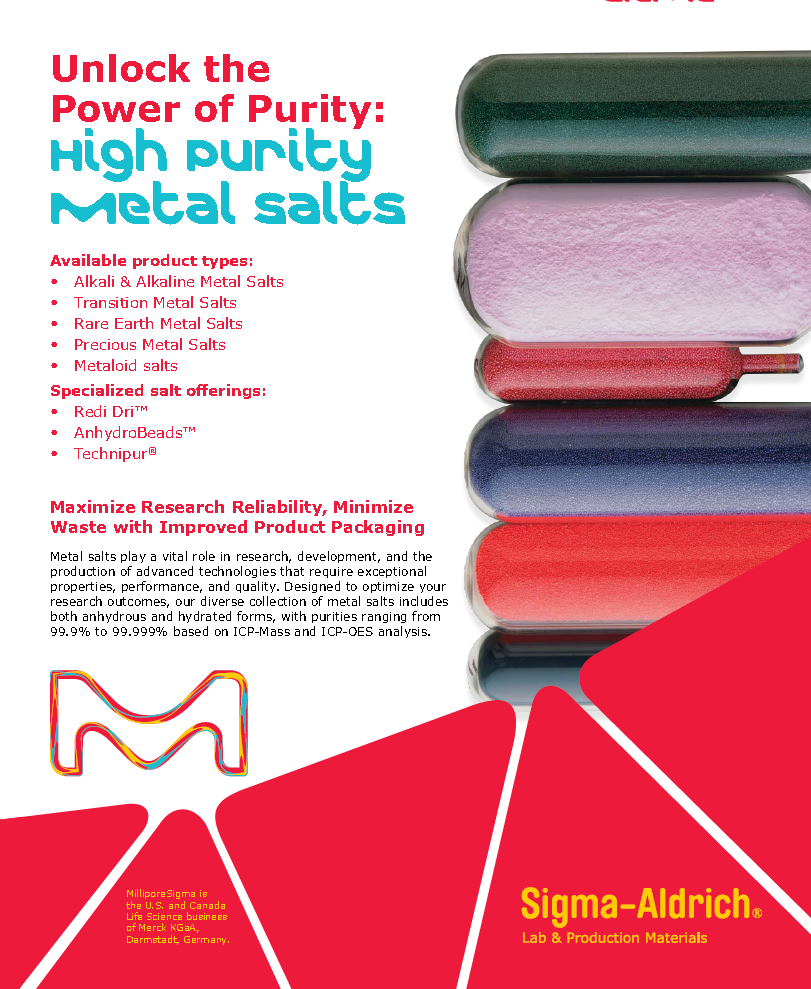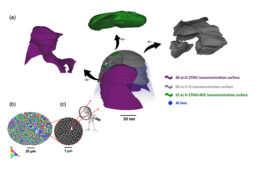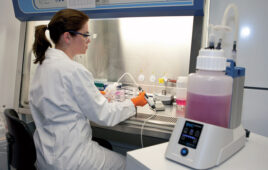
By Rama Ghosh, Ph.D., Global Product Manager, MilliporeSigma
High-purity salts are finding new applications in the synthesis of next-generation battery materials, supercapacitors, inorganic nanoparticles, electronic devices, and organic reactions. These salts undergo rigorous purification processes to eliminate impurities and contaminants, resulting in a products with exceptional chemical purity.
MilliporeSigma offers high-purity salts, both anhydrous and hydrated, ranging from 99.9% to 99.999% purity as measured by inductively coupled plasma mass spectrometry (ICP-MS) or inductively coupled plasma optical emission spectrometry (ICP-OES). These include (1) transition metal salts, (2) rare earth salts, (3) precious metal salts, and (4) alkali and alkaline salts.
Table 1: Typical ICP–MS analysis results of nickel(II) nitrate hexahydrate salts (203874) in ppm
| Element | Ni(NO3)2. 6H2O, 99.999% |
| Trace Metal Analysis | 7.1 ppm |
| Aluminum (Al) | 0.5 ppm |
| Barium (Ba) | 0.9 ppm |
| Calcium (Ca) | 0.5 ppm |
| Chromium (Cr) | 0.2 ppm |
| Copper (Cu) | 1.9 ppm |
| Iron (Fe) | 0.8 ppm |
| Potassium (K) | 0.4 ppm |
| Magnesium (Mg) | 0.2 ppm |
| Sodium (Na) | 0.6ppm |
| Zinc (Zn) | 1.1 ppm |
AnhydroBeads™ Salts
Experience exceptional quality with our AnhydroBeads™ salts for technical synthesis applications, such as photovoltaics. With a water content on the parts-per-million scale and trace metal purity of 99.9% (3N) to 99.999% (5N), our salts are produced and tested under stringent dry manufacturing conditions to ensure optimal quality. Their low surface area-to-volume ratio of ~2 mm in diameter minimizes common issues associated with crystalline powders, ensuring high performance in pneumatic loading. Widely used in photovoltaics, batteries, and moisture-sensitive catalytic reactions, AnhydroBeads™ salts are the solution to your technical synthesis needs.
Table 2: Typical ICP–MS analysis results for MilliporeSigma AnhydroBeads™ salts in ppm
| Element | Lead iodide, 99.999% 554359 |
| Trace Metal Analysis | 7.2 ppm |
| Aluminum (Al) | 0.3 ppm |
| Barium (Ba) | 0.2 ppm |
| Bismuth (Bi) | 0.4 ppm |
| Calcium (Ca) | 0.8 ppm |
| Chromium (Cr) | 0.2 ppm |
| Iron (Fe) | 1.6 ppm |
| Sodium (Na) | 0.2 ppm |
| Zinc (Zn) | 1.1 ppm |
| Silver (Ag) | 2.4 ppm |
Applications
The purity of salts is a crucial factor that determines their suitability as candidates for synthesizing a broad range of materials, including cathode active materials for batteries, fuel cell catalysts, optoelectronic devices, nanomaterials, and more.

Energy storage:
In the pursuit of better battery technology, scientists are actively exploring new frontiers beyond traditional Li-ion batteries. Driving this is the need for batteries with greater energy density, faster charging times, and longer lifetimes. Prioritizing precursor materials with low impurity levels is crucial to ensuring the desired performance of battery components. Identifying and eliminating impurities is key to producing high-quality materials that meet the exacting requirements of battery applications. For example, impurities present in battery materials can lead to catastrophic consequences such as failure, overheating, and fires.
At MilliporeSigma, we prioritize the purity of our battery-grade lithium salts, which boast trace metal purity levels ranging from 99.9% to 99.999%. By carefully controlling impurities such as sodium, potassium, lead, zinc, aluminum, chlorine, sulfates, etc., we can help prevent potential safety risks and guarantee exceptional performance of the materials.
Table 3. Typical ICP–MS analysis results of Li salts from MilliporeSigma
| Element | LiF ≥99.99% (449903) | Li2CO3, 99.99% (431559) |
| Trace Metal Analysis | 15.2 ppm | 71.0 ppm |
| Sodium (Na) | 1.3 ppm | 0.5 ppm |
| Potassium (K) | 1.7 ppm | 0.5 ppm |
| Aluminum (Al) | 0.5 ppm | 0.5 ppm |
| Arsenic (As) | 1.8 ppm | – |
| Calcium (Ca) | 4.6 ppm | 66.1 ppm |
| Iron (Fe) | 1.0 ppm | 0.5 ppm |
| Magnesium (Mg) | 1.3 ppm | 0.4 ppm |
| Zinc (Zn) | 0.8 ppm | 0.3 ppm |
| Rubidium (Rb) | – | 0.2 ppm |
Table 4: Battery-grade lithium salts from MilliporeSigma
| Battery-grade Lithium Salts | Specifications | MilliporeSigma Product No |
| Lithium carbonate | ≥99.9% trace metals basis | 931942 |
| Lithium hexafluorophosphate | ≥99.99% trace metals basis | 450227 |
| Lithium hydroxide monohydrate | ≥99.9% trace metals basis | 930903 |
| Lithium nitrate | anhydrous, ≥99.9% trace metals basis | 930946 |
| Lithium tetrafluoroborate | ultra-dry, powder, 99.99% trace metals basis | 451622 |
Synthesis of cathode active materials:
The growing market for Li-ion batteries (LIBs) is driving the development of battery technology and placing greater demand on metal salts such as cobalt, nickel, and manganese. Controlling contaminants in raw materials during synthesis is critical as the morphology and purity of the cathode active materials strongly impact the cathode’s capacity, stability, and lifetime. Various techniques are employed to synthesize cathode active materials, including the solid-state, sol-gel, and co-precipitation methods. By leveraging different types of metal salts as precursor materials and exercising careful control over the synthesis process, these methods create materials with precise properties tailored to meet the specific needs of battery applications.[1-6]
Table 5: Various synthesis methods and pertinent MilliporeSigma salts used to produce cathode-active materials
| Synthesis methods | Popular Metal Salts | Specifications | MilliporeSigma Product No |
| Co-precipitation | Nickel (II) sulfate heptahydrate Cobalt (II) sulfate hydrate Manganese (II) sulfate hydrate |
99.999% trace metals basis 99.998% trace metals basis ≥99.99% trace metals basis |
203890 229598 229784 |
| Sol-gel synthesis | Nickel (II) nitrate hexahydrate Cobalt (II) nitrate hexahydrate, Manganese (II) nitrate hydrate |
99.999% trace metals basis 99.999% trace metals basis 99.99% trace metals basis |
203874 203106 203742 |
| Solvothermal synthesis | Iron (II) oxalate dihydrate Magnesium nitrate hexahydrate Aluminum nitrate nonahydrate |
≥99.99% trace metals basis 99.999% trace metals basis 99.997% trace metals basis |
255971 203696 229415 |
| Spray pyrolysis synthesis | Cobalt (II) chloride hydrate Manganese (II) chloride Nickel (II) chloride hexahydrate |
99.999% trace metals basis 99.99% trace metals basis 99.999% trace metals basis |
203084 429449 203866 |
| Solid state synthesis | Aluminum hydroxide hydrate Nickel (II) hydroxide Cobalt (II) hydroxide |
powder, <45 μm technical grade, 95% |
769460 283622 342440 |
Visit MilliporeSigma to explore our full range of battery materials.
Fuel Cell

Fuel cells have generated significant interest across various research groups as a promising alternative for producing high-power, cleaner energy [7]. Currently, noble metal-based materials such as nanoparticles, core shells, metallic alloys, and nanocomposites are the most efficient electrocatalysts for fuel cells, whether in the context of oxygen evolution reaction (OER) or hydrogen evolution reaction (HER) [8-11]. It has been reported that platinum and Pt-rare earth metal alloys hold great potential as catalysts for the oxygen reduction reaction (ORR) in fuel cells. These Pt-RE alloys have been found to exhibit some of the highest ORR activities among all ORR catalysts ever reported [12]. Various techniques using high-purity metal salts are employed to synthesize these catalysts, including sol-gel, solid-state, and co-precipitation methods.
Table 6: A few examples of building block salts for fuel cell catalysts offered by MilliporeSigma:
| Popular Metal Salts | Specifications | MilliporeSigma Product No |
| Platinum (II) acetylacetonate | ≥99.98% trace metals basis | 523038 |
| Tetraammineplatinum (II) nitrate | 99.995% trace metals basis | 482293 |
| Palladium (II) nitrate dihydrate | ~40% Pd basis | 76070 |
| Ruthenium (III) chloride hydrate Molybdenum(V) chloride |
ReagentPlus® 99.99% trace metals basis |
206229 642452 |
| Yttrium (III) chloride hexahydrate Gadolinium (III) chloride hexahydrate Lanthanum (III) chloride heptahydrate |
99.9% trace metals basis 99.999% trace metals basis 99.999% trace metals basis |
211648 203289 203521 |
Due to the high cost of noble metal catalysts such as platinum and palladium, a significant amount of research has been conducted to explore the feasibility of replacing these expensive materials with more affordable non-precious metal catalysts [13-14]. This work uses different transition salts of sulfate, nitrate, and acetate chloride to synthesize a catalyst.
Table 7: A selection of salts used to produce non-precious metal electrocatalysts for fuel cells:
| Popular Metal salts | Specifications | MilliporeSigma Product No |
| Iron (III) nitrate nonahydrate | ≥99.999% trace metals basis | 529303 |
| Cobalt (II) chloride hexahydrate | ≥97% | 769495 |
| Manganese (II) sulfate hydrate | ≥99.99% trace metals basis | 229784 |
| Iron (II) chloride tetrahydrate | 99.99% trace metals basis | 380024 |
| Cobalt (II) nitrate hexahydrate | 99.999% trace metals basis | 203106 |
Optoelectronic Device:
Metal-perovskite semiconductor materials have been widely researched due to their remarkable optoelectronic properties. These characteristics render them highly promising for various applications, including solar cells, light-emitting diodes, X-ray detectors, and more [15]. Metal halides (MX2) with metals such as Ba, Cs, Pb, Sn, and Bi and halogens such as Cl, Br, and I are ideal precursors for creating metal halide perovskite semiconductor materials [16-17].
Table 8: Various salts used to produce metal halide perovskite semiconductor materials:
| Popular Metal halides | Specifications | MilliporeSigma Product No |
| Lead (II) iodide | AnhydroBeads™, −10 mesh, 99.999% trace metals basis | 554359 |
| Lead (II) bromide | 99.999% trace metals basis | 398853 |
| Cesium chloride | 99.99% trace metals basis | 562599 |
| Cesium bromide | 99.999% trace metals basis | 203017 |
| Tin (II) iodide | −10 mesh, 99.999% trace metals basis | 466352 |
Electronic/Semiconductor Industry:
Thinner coatings are becoming increasingly prevalent in the electronics and semiconductor industries due to advancements in technology and design. As a result, it is crucial to reduce interfering elements to ensure optimal performance. Precursor materials such as metal salts must be monitored through ICP-MS or ICP-OES to ensure contamination limits at the ppm level.
At MilliporeSigma, we prioritize the purity of platinum group metal salts, ensuring trace metal purity levels within the range of 99.9% to 99.999% as measured by ICP-MS. Maintaining such stringent levels of purity is critical for the electronics industry, as it minimizes performance risks.
Table 9: Various platinum groups of metal salts for the electronic/semiconductor industries:
| Popular Metal Salts | Specifications | Product No |
| Gold (III) chloride hydrate | 99.995% trace metals basis | 254169 |
| Potassium tetrachloroplatinate (II) | 99.99% trace metals basis | 323411 |
| Ruthenium (III) chloride hydrate | ≥99.9% trace metals basis | 931578 |
| Iridium (III) chloride hydrate | 99.9% trace metals basis | 203491 |
| Rhodium (III) chloride hydrate | 99.95% trace metals basis | 450286 |

Learn more about these products with our “High-Purity Salts” brochure.
References
- B. Gupta, et.al., J. Mater. Chem. A, 2023,11, 3789-3821
- Dong, G. M. Koenig, CrystEngComm, 2020, 22, 1514-1530
- A. Cussen, et.al., Energy Reports,2022, 8, 67-73
- Wang, et.al., RSC Adv., 2015,5, 40779-40784
- Wang, et.al., J. Phys. Chem. C, 2015, 119, 2266−2276
- Liu, et.al., J. Mater. Chem., 2010,20, 8086-8091
- L. Soloveichik, Beilstein. J. Nanotechnol. 2014, 5, 1399–1418
- Jong-Beom Baek et.al., ACS Omega 2020, 5, 31−40
- Tang, et.al., Nanomaterials 2022, 12, 2618
- Zhou et.al., Appl. Sci. 2023, 13, 2177
- Ribeiro et.al., Materials for Renewable and Sustainable Energy ,2021, 10:5
- Wang, et.al., J. Mater. Chem. A, 2016, 4, 17587–17603
- Wu., et.al., Acc. Mater. Res. 2022, 3, 2, 224–236
- Mecheri, et.al., Catalysts 2020, 10, 475
- Garcia-Belmonte, et.al., Chem. Rev. 2021, 121, 23, 14430–14484
- J. Snaith, et.al., Nature Nanotechnology 2015,10, 391–402
- Y. Qi, et.al., J. Mater. Chem. A, 2021,9, 22759-22780
Sponsored content by Merck





Tell Us What You Think!